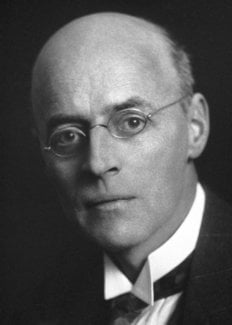Owen Willans Richardson
Biographical
 Owen Willans Richardson was born on the 26th of April, 1879, at Dewsbury, Yorkshire, England, as the only son of Joshua Henry and Charlotte Maria Richardson.
Owen Willans Richardson was born on the 26th of April, 1879, at Dewsbury, Yorkshire, England, as the only son of Joshua Henry and Charlotte Maria Richardson.
Educated at Batley Grammar School, he proceeded to Cambridge in 1897, having obtained an Entrance Major Scholarship at Trinity College; he gained First Class Honours in Natural Science at the examinations of the Universities of Cambridge and London, with particular distinctions in Physics and Chemistry. After graduating at Cambridge in 1900, he began to investigate the emission of electricity from hot bodies at the Cavendish Laboratory. In 1902 he was elected a Fellow of Trinity College, Cambridge. The law for the discovery of which the Nobel Prize was specially given, was first announced by him in a paper read before the Cambridge Philosophical Society on the 25th November, 1901, in the following words, as recorded in the published Proceedings: “If then the negative radiation is due to the corpuscles coming out of the metal, the saturation current s should obey the law s = AT1/2e-b/T. This law is fully confirmed by the experiments to be described.” Richardson continued working at this subject at Cambridge until 1906, when he was appointed Professor of Physics at Princeton University in America, where he remained until the end of 1913, working at thermionic emission, photoelectric action, and the gyromagnetic effect. In 1911 he was elected a member of the American Philosophical Society, and in 1913 a Fellow of the Royal Society, whereupon (1914) he returned to England as Wheatstone Professor of Physics at King’s College in the University of London. Among his publications were: The Electron Theory of Matter, 1914 (2nd ed., 1916), The Emission of Electricity from Hot Bodies, 1916 (2nd ed., 1921), Molecular Hydrogen and its Spectrum, 1934.
He was awarded the Hughes Medal by the Royal Society (1920), especially for work on thermionics; elected President, Section A, of the British Association (1921) and President of the Physical Society, London (1926-1928); appointed Yarrow Research Professor of the Royal Society, London (1926-1944), and knighted in 1939. Since 1914 he worked at thermionics, photoelectric effects, magnetism, the emission of electrons by chemical action, the theory of electrons, the quantum theory, the spectrum of molecular hydrogen, soft X-rays, the fine structure of Ha and Da. His last paper, with E. W. Foster, appeared in 1953. He received honorary degrees from the Universities of St. Andrews, Leeds, and London.
In 1906 he married Lilian Maud Wilson, the only sister of the well-known physicist H. A. Wilson, who was a fellow-student with him in Cambridge. There were two sons and one daughter of this marriage. After the death of his wife in 1945, Richardson married the physicist Henriette Rupp in 1948; he himself died in 1959.
This autobiography/biography was written at the time of the award and first published in the book series Les Prix Nobel. It was later edited and republished in Nobel Lectures. To cite this document, always state the source as shown above.
Owen Willans Richardson died on February 15, 1959.
Nobel Prizes and laureates
Six prizes were awarded for achievements that have conferred the greatest benefit to humankind. The 14 laureates' work and discoveries range from quantum tunnelling to promoting democratic rights.
See them all presented here.
